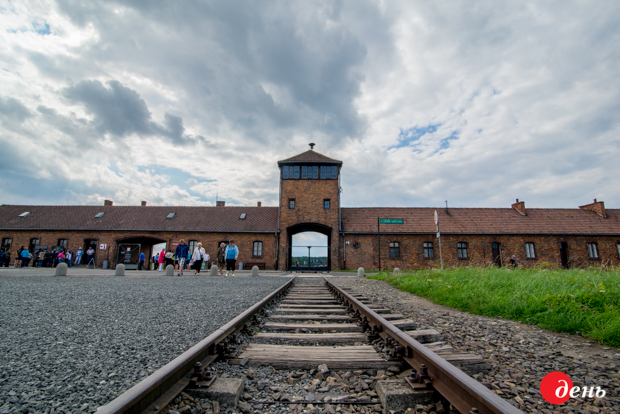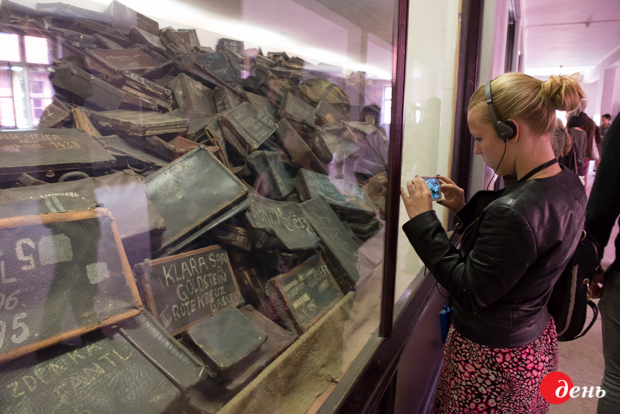A tour of the Auschwitz-Birkenau camp
Den’s special reporter visited the concentration camp which was liberated by the First Ukrainian Front of the Red Army on January 27, 70 years ago
“The Nazis used about 20 tons of the Cyclone B gas in just two years (1942-43) for mass murder of prisoners. After 20 minutes in the gas chamber, they shorn off hair from the corpses, which was already gray by that moment, and subsequently used it as insulation material, filler for blankets or quilts…,” the Polish guide recited the memorized phrases in a calm voice.
Our group of English-speaking tourists was just passing by the mountain of human remains which was separated from us by a glass barrier. The next room housed a mountain of shoes, which were worn by women 75 years ago. Thousands of leather suitcases with names of owners, hastily written in white paint, lay opposite that mountain.
“They removed jewelry from the corpses and pulled out gold teeth. The corpses were then sent to the crematorium,” the guide continued.
It is unlikely for mere words to convey the sheer horror of the procedures used there to deal primarily with Jews, and to a lesser extent other ethnic groups, including Gypsies, Poles, and nearly 15,000 Ukrainians. Children, elderly, disabled, wounded and sick were all doomed.

OFFICIALLY, ADMISSION TO THE MUSEUM IS FREE, BUT VISITORS WILL HAVE TO PAY FOR THE SERVICES OF A GUIDE WHO WILL CONDUCT A 4-HOUR-LONG EXCURSION – 25 ZLOTYS IN POLISH AND FROM 40 ZLOTYS ($10) UP IN OTHER LANGUAGES
Arbeit macht frei (work makes free) was a “credo” of prisoners, still visible above the entrance gate of the camp, woven from iron letters. They worked primarily on the camp’s expansion, but also performed work for the chemical, metallurgical, and military concerns. However, their productivity was not too high, as constant fatigue and hunger took their toll. People often died in their “workplaces,” long before they would be killed with the deadly gas. It is estimated that 1,500,000 people were killed in Auschwitz-I, Auschwitz II-Birkenau and Auschwitz III-Monowitz. This is according to official figures. It is already clear that this was the most massive single loss of human life in the history of humankind.
“As many as 20 rail cars with jewelry and valuables formerly belonging to prisoners were sent to Germany daily. All ‘useless’ belongings were burned in the camp itself at once. The store of valuables, named ‘Canada’ after what people saw as a rich country in the Americas, was the place where prisoners sorted out belongings just taken from the freshly arrived people..,” the audio guide talks in poor English.
After the Germans occupied Poland, they established a concentration camp in a former military barracks. The city itself was renamed Auschwitz. Polish population was evicted from the surrounding area, and when the military barracks of Auschwitz-I proved to be not enough, they began building Auschwitz II nearby, the concentration camp which is actually associated with this place now.
It has housed a museum since 1947 that is listed as a World Heritage Site. The camp gets over a million visitors per year. In 2005, the UN declared January 27 to be the International Holocaust Remembrance Day.

THE MAIN GATE OF BIRKENAU. THIS CAMP CLAIMED ABOUT A MILLION HUMAN LIVES. BARRACKS BEGAN TO BE BUILT HERE IN 1941. SEVERAL FREIGHT TRAINS ANNUALLY BROUGHT NEW INMATES THROUGH THIS GATE UNTIL 1945
It was on January 27, 1945 that the First Ukrainian Front of the Red Army liberated the concentration camp, which fact was recently recalled by Polish Foreign Minister Grzegorz Schetyna on the Polish Radio, as he commented on criticism that Poland allegedly failed to invite the Russian president to the celebrations of the 70th anniversary of the camp’s liberation. “Would not it be more correct to say that it was the First Ukrainian Front and Ukrainians who liberated it? Because Ukrainians were the ones to open the gates and liberate the camp on that January day,” Schetyna said.
“Those who were neither condemned to death and sent to the crematorium outright, nor designated as workers or women working in ‘Canada,’ were subjected to ‘medical experiments.’ Josef Mengele, also known as ‘Doctor Death’ or the ‘Angel of Death,’ was the chief doctor of the camp and conducted genetic and anthropological research which included experiments on humans, especially twin children and children with disabilities..,” our female guide said as calmly as before.
Mengele, who fled to Brazil after the war and died in 1979 without ever suffering punishment for his crimes, tested medicines, conducted experiments with narcotics, made skin transplants, and used X-rays to sterilize several hundred women daily, all in the name of advancing the Third Reich’s healthcare...

OBVIOUSLY, AUSCHWITZ IS ONLY ONE IN A LONG CHAIN OF NAZI GERMANY’S CONCENTRATION CAMPS. HOWEVER, THE VERY SCALE OF PEOPLE’S EXTERMINATION REALLY SHOCKS. BY WAY OF COMPARISON, 60,000 PEOPLE WERE TORTURED TO DEATH IN DACHAU, 70,000 IN BUCHENWALD, 300,000 IN MAJDANEK, AND 800,000 IN TREBLINKA
Most Auschwitz prisoners died, but quite a few survived or escaped. One woman weighed 75 kilograms on her arrival to the camp, had her weight come down to 25 kilograms, but still managed to escape. Only 200 people from more than 800,000 escaped.
Prisoners, regardless of age, were tattooed with a triangle and a country code.
The typical daily diet included soup, half a loaf of bread and tea. Wooden shoes that did not allow normal movement, a set of clothing sterilized once a month, rats, five hours of sleep per day, the punishment cell with 0.9 square meters of floor space which housed four people at once, the wall of death where several thousand people were shot...
By the way, some prisoners were ethnic Germans. While for Jews or Gypsies the ethnicity itself was the sufficient cause for imprisonment, ethnic Germans got here because of their political or religious beliefs or sexual orientation. Some people were sent to the camp for a few months of “re-education,” but few of them survived their terms.
It is known that there were many Ukrainians in the camp. Risk of being sent to Auschwitz was highest for activists with political backgrounds and Soviet prisoners of war. For example, members of the Organization of Ukrainian Nationalists (OUN), brothers of Stepan Bandera Oleksandr and Vasyl died in Auschwitz I. After the OUN proclaimed the Ukrainian State on June 30, 1941, many leaders of the Ukrainian nationalists, including Lev Rebet and Stepan Lenkavsky, were sent here. About 200 “political” Ukrainian prisoners, that is, members of the OUN, spent some time in Auschwitz, and several hundred were held in other German concentration camps.
The crematorium’s capacity allowed incinerating up to 700 people in 40 minutes under the conditions of 2,000 degrees temperature. Symbolically, the camp’s internal prison commandant Rudolf Hoess was hanged next to the prison on the gallows specially designed for this occasion in 1947. “Above all, we must listen to the Fuehrer, not philosophize,” Hoess testified at his trial in April of that year. We realize with horror how much evil is still being done by the perversion of ideological fanaticism. According to the SS Obersturmbannfuehrer Hoess’s trial testimony, 2.5 million people were killed in the Auschwitz camp complex.
“We will go to Birkenau now. You will be able to see much more there,” the tour guide’s commentary runs as I replay the record for the third time and understand that I underestimated the scale of this “much more” then. Several hundred leaky barracks with bunks for up to 10 prisoners per unit, four gas chambers and crematoria, 46 furnaces which incinerated 8,000 corpses daily, without ever stopping...






